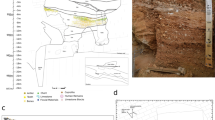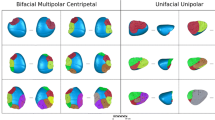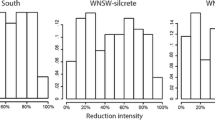Abstract
Knowing to what extent lithic cores have been reduced through knapping is an important step toward understanding the technological variability of lithic assemblages and disentangling the formation processes of archaeological sites. In addition, it is a good complement to more developed studies of reduction intensity in retouched tools and provides information on raw material management or site occupation dynamics. This paper presents a new methodology for estimating the intensity of reduction in cores and tools on cobbles, the Volumetric Reconstruction Method (VRM). It is based on a correction of the dimensions (length, width, and thickness) of each core from an assemblage. The median values of thickness and platform thickness of the assemblage’s flakes are used as corrections for the cores’ original dimensions, after its diacritic analysis. Then, based on these new dimensions, the volume or mass of the original blank are reconstructed using the ellipsoid volume formula. The accuracy of this method was experimentally tested, reproducing a variety of possible archaeological scenarios. The experimental results demonstrate a high inferential potential of the VRM, both in estimating the original volume or mass of the original blanks and in inferring the individual percentage of reduction for each core. The results of random resampling demonstrate the applicability of VRM to not size-biased archaeological contexts.









Similar content being viewed by others
References
Andrefsky WJ (1994) Raw-material availability and the organization of technology. Am Antiq 59:21–34
Andrefsky WJ (2008) Lithic technology: measures of production, use and curation. Cambridge University Press, Cambridge
Blades BS (2003) End scraper reduction and hunter-gatherer mobility. Am Antiq 68:141–156
Bradbury AP, Carr PJ (1999) Examining stage and continuum models of flake debris analysis: an experimental approach. J Archaeol Sci 26:105–116
Bustos-Pérez G, Baena J (2019) Exploring volume lost in retouched artifacts using height of retouch and length of retouched edge. J Archaeol Sci Rep 27:101922. https://doi.org/10.1016/j.jasrep.2019.101922
Carr PJ, Bradbury AP (2011) Learning from lithics: a perspective on the foundation and future of the organisation of technology. PaleoAnthropology:305–319. https://doi.org/10.4207/PA.2011.ART61
Clarkson C (2002) An index of invasiveness for the measurement of unifacial and bifacial retouch : a theoretical , experimental and archaeological verification. J Archaeol Sci 29:65–75. https://doi.org/10.1006/jasc.2001.0702
Clarkson C (2013) Measuring core reduction using 3D flake scar density : a test case of changing core reduction at Klasies River Mouth , South Africa. J Archaeol Sci 40:4348–4357. https://doi.org/10.1016/j.jas.2013.06.007
Clarkson C, Hiscock P (2011) Estimating original flake mass from 3D scans of platform area. J Archaeol Sci 38:1062–1068. https://doi.org/10.1016/j.jas.2010.12.001
Dibble HL, Bernard MC (1980) A comparative study of basic edge angle measurement techniques. Am Antiq 45:857–865
Dibble HL, Rezek Z (2009) Introducing a new experimental design for controlled studies of flake formation: results for exterior platform angle, platform depth, angle of blow, velocity, and force. J Archaeol Sci 36:1945–1954. https://doi.org/10.1016/j.jas.2009.05.004
Dibble HL, Schurmans UA, Iovita RP, McLaughlin MV (2005) The measurement and interpretation of cortex in lithic assemblages. Am Antiq 70:545–560
Ditchfield K (2016a) An experimental approach to distinguishing different stone artefact transport patterns from debitage assemblages. J Archaeol Sci 65:44–56
Ditchfield K (2016b) The influence of raw material size on stone artefact assemblage formation: an example from Bone Cave, south-western Tasmania. Quat Int. https://doi.org/10.1016/j.quaint.2016.03.013
Ditchfield K, Holdaway SJ, Allen MS, McAlister A (2014) Measuring stone artefact transport: the experimental demonstration and pilot application of a new method to a prehistoric adze workshop, southern Cook Islands. J Archaeol Sci 50:512–523
Douglass MJ, Holdaway SJ, Fanning PC, Shiner JI (2008) An assessment and archaeological application of cortex measurement in lithic assemblages. Am Antiq 73:513–526
Douglass MJ, Lin SC, Braun DR, Plummer TW (2018) Core use-life distributions in lithic assemblages as a means for reconstructing behavioral patterns. J Archaeol Method Theory 25:254–288. https://doi.org/10.1007/s10816-017-9334-22
Eren MI, Domínguez-Rodrigo M, Kuhn SL, Adler DS, Le I, Bar-Yosef O (2005) Defining and measuring reduction in unifacial stone tools. J Archaeol Sci 32:1190–1201. https://doi.org/10.1016/j.jas.2005.03.003
Hiscock P, Tabrett A (2010) Generalization , inference and the quantification of lithic reduction. World Archaeol 42:545–561. https://doi.org/10.1080/00438243.2010.517669
Holdaway SJ, Shiner JI, Fanning PC (2008) Assemblage formation as a result of raw material acquisition in western New South Wales. Australia Lithic Technol 23:1–16
Iovita R (2011) Shape variation in Aterian tanged tools and the origins of projectile technology : a morphometric perspective on stone tool function. PLoS One 6:e2029. https://doi.org/10.1371/journal.pone.0029029
Kuhn SL (1990) A geometric index of reduction for unifacial stone tools. J Archaeol Sci 17:583–593
Leroi-Gourhan A (1993) Gesture and speech. MIT Press, Cambridge
Li H, Kuman K, Li C (2015) Quantifying the reduction intensity of handaxes with 3D technology : a pilot study on handaxes in the Danjiangkou Reservoir Region , Central China. PLoS One 10:e0135613. https://doi.org/10.1371/journal.pone.0135613
Lin SC, Douglass MJ, Holdaway SJ, Floyd B (2010) The application of 3D laser scanning technology to the assessment of ordinal and mechanical cortex quantification in lithic analysis. J Archaeol Sci 37:694–702. https://doi.org/10.1016/j.jas.2009.10.030
Lin SC, Mcpherron SP, Dibble HL (2015) Establishing statistical confidence in cortex ratios within and among lithic assemblages : a case study of the middle Paleolithic of southwestern France. J Archaeol Sci 59:89–109. https://doi.org/10.1016/j.jas.2015.04.004
Lombao D (2019) VRM experiment raw data [data set]. Zenodo. https://doi.org/10.5281/zenodo.3368659
Lombao D, Cueva-Temprana A, Rabuñal JR, Morales JI, Mosquera M (2019) The effects of blank size and knapping strategy on the estimation of core’s reduction intensity. Archaeol Anthropol Sci 11:5445–5461
Morales JI (2016) Distribution patterns of stone-tool reduction : establishing frames of reference to approximate occupational features and formation processes in Paleolithic societies. J Anthropol Archaeol 41:231–245. https://doi.org/10.1016/j.jaa.2016.01.004
Morales JI, Lorenzo C, Vergès JM (2015) Measuring retouch intensity in lithic tools : a new proposal using 3D scan data. J Archaeol Method Theory 22:543–558. https://doi.org/10.1007/s10816-013-9189-0
Muller A, Clarkson C (2014) Estimating original flake mass on blades using 3D platform area : problems and prospects. J Archaeol Sci 52:31–38. https://doi.org/10.1016/j.jas.2014.08.025
Muller A, Clarkson C, Baird D, Fairbairn A (2018) Reduction intensity of backed blades: blank consumption, regularity and efficiency at the early Neolithic site of Boncuklu, Turkey. J Archaeol Sci Rep 21:721–732. https://doi.org/10.1016/j.jasrep.2018.08.042
Nelson MC (1991) The study of technological organization. Archaeol Method Theory 3:57–100
Odell GH (2001) Stone tool research at the end of the millennium: classification, function, and behaviour. J Archaeol Res 9:45–100
Phillipps RS, Holdaway SJ (2016) Estimating core number in assemblages : core movement and mobility during the Holocene of the Fayum , Egypt. J Archaeol Method Theory 23:520–540. https://doi.org/10.1007/s10816-015-9250-2
R Core Team, 2013. R: a language and environment for statistical computing 3
Rolland N, Dibble HL (1990) A new synthesis of Middle Palaeolithic variability. Am Antiq 55:480–499
Schiffer MB (1987) Formation processes of the archaeological record. University of New Mexico Press, Albuquerque
Sellet F (1993) Chaîne Opératoire: the concept and its applications. Lithic Technol 18:106–112
Shipton C (2011) Taphonomy and behaviour at the Acheulean site of Kariandusi. Kenya African Archaeol Rev 28:141–155
Shott MJ (1996) An exegesis of the curation concept. J Anthropol Res 52:259–280
Shott MJ (2002) Weibull estimation on use life distribution in experimental spear-point data. Lithic Technol 27:93–109. https://doi.org/10.1080/01977261.2002.11720993
Shott MJ (2003) Chaîne Opératoire and reduction sequence. Lithic Technol 28:95–105
Shott MJ, Seeman MF (2015) Curation and recycling: estimating Paleoindian endscraper curation rates at Nobles Pond, Ohio. USA Quat Int 361:319–331
Shott MJ, Sillitoe P (2004) Use-life distributions in archaeology using New Guinea Wola ethnographic data. Am Antiq 69:339–355
Shott MJ, Sillitoe P (2005) Use life and curation in New Guinea experimental used flakes. J Archaeol Sci 32:653–663. https://doi.org/10.1016/j.jas.2004.11.012
Shott MJ, Weedman KJ (2007) Measuring reduction in stone tools: an ethnoarchaeological study of Gamo hidescrapers from Ethiopia. J Archaeol Sci 34:1016–1035
Shott MJ, Bradbury AP, Carr PJ, Odell GH (2000) Flake size from platform attributes: predictive and empirical approaches. J Archaeol Sci 27:877–894
Acknowledgments
This manuscript would not have been possible if not for the invaluable insights, suggestions, and assistance of José Ramón Rabuñal throughout the whole process, from the original VRM design to the revision of the manuscript. Furthermore, we want to thank Dr. Andreu Ollé, Dr. María Gema Chacón and José Ramón Rabuñal for participating in the experimental program, and also Dr. Andreu Ollé, Dr. Paula García-Medrano, and Dr. Adrián Arroyo for their help in the collection of raw material used in the experiment. Last, thank the editor and two anonymous reviewers for their constructive comments, which helped us to improve the manuscript. Any potential mistake is authors’ responsibility only.
Funding
This work has been carried out with the financial support of the Generalitat de Catalunya, AGAUR agency, the 2017SGR1040 Research Group, 2019PFR-URV-91, and the Spanish Ministry of Science, Innovation and Universities (MICINN/FEDER project PGC2018-093925-B-C32) and (HAR2017-86509-P). IPHES is a CERCA center. D.L. is a beneficiary of PhD research fellowship AGAUR/ESF “ESF, Investing in your future” (2020 FI_B2 00164). J.I.M. is funded by the program Juan de la Cierva-Incorporación (IJCI-2017-31445).
Author information
Authors and Affiliations
Corresponding author
Ethics declarations
Competing interests
The authors declare that they have no competing interests.
Additional information
Publisher’s note
Springer Nature remains neutral with regard to jurisdictional claims in published maps and institutional affiliations.
Rights and permissions
About this article
Cite this article
Lombao, D., Cueva-Temprana, A., Mosquera, M. et al. A new approach to measure reduction intensity on cores and tools on cobbles: the Volumetric Reconstruction Method. Archaeol Anthropol Sci 12, 222 (2020). https://doi.org/10.1007/s12520-020-01154-7
Received:
Accepted:
Published:
DOI: https://doi.org/10.1007/s12520-020-01154-7




